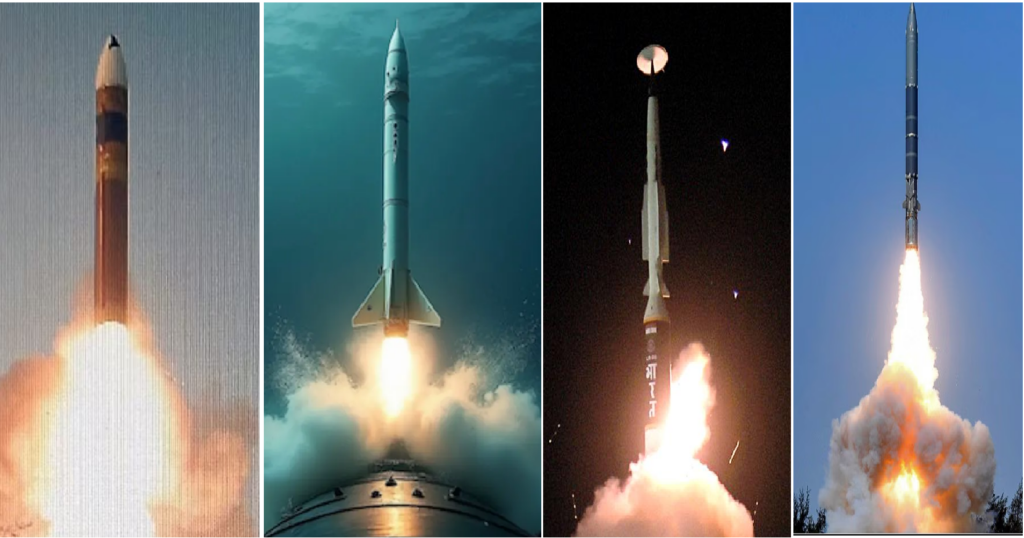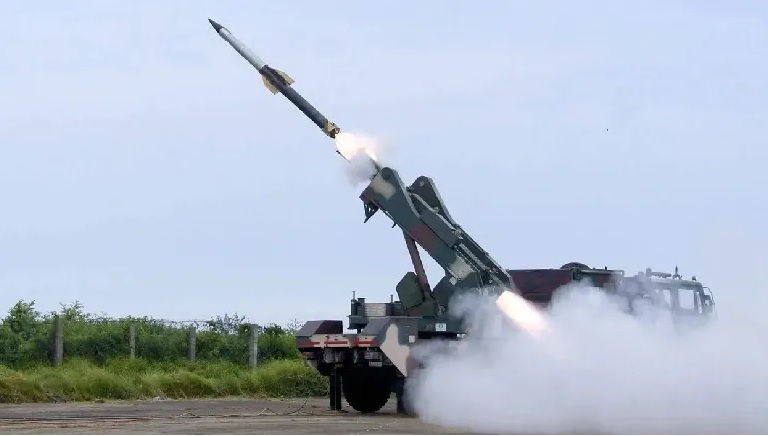
- India’s military strategy and place in world geopolitics will be shaped by the advancement of its missile and defence technologies.
- Test launches of nuclear-capable intercontinental ballistic missiles, hypersonic weapons, and sophisticated anti-submarine systems suggested that India was becoming a major leader in missile technology.
- In addition to enhancing the deterrence posture, missile technologies give India the ability to respond to any new threats with the appropriate degree of effectiveness.
India’s defence capabilities advanced significantly in 2024 as the nation successfully tested several advanced missile systems intended to strengthen its position as a powerful global defence power, improve strategic deterrence, and safeguard national security. Test launches of nuclear-capable intercontinental ballistic missiles, hypersonic weapons, and sophisticated anti-submarine systems suggested that India was becoming a major leader in missile technology. A thorough analysis of some of the major missile tests in 2024 and their strategic importance is presented in this article.
Project Divyastra: Using MIRV Technology with Agni-5
An important turning point in India’s nuclear deterrence strategy was reached in March 2024 with the successful test of the Agni-5 missile by the Defence Research and Development Organization, the country’s top defence research organization. With a range of more than 5,000 kilometres, the Agni-5 is a nuclear-capable ICBM that was created to provide India with a credible second-strike capability. Since this is one of the key features of India’s NFU nuclear policy, it gives the nation the capacity to react effectively in the event of a nuclear strike.
The MIRV technology’s successful demonstration was the test’s high point in March 2024. The Agni-5 can carry multiple warheads and use each one to target various locations because of MIRV technology. This capability guarantees that the Agni-5 can overwhelm advanced missile defence systems by simultaneously attacking several sites, preserving India’s deterrent strength if an adversary develops such systems.
This solid-fueled, three-stage rocket features an RLG and a sophisticated INS. Stability is provided by the carbon composite airframe, and the missile may be heated and launched into the atmosphere to reach its destination thanks to its heat-shielded re-entry vehicle. In this sense, the fact that it is launched from a canister facilitates both easy mobility and rapid deployments, thereby establishing a deterrent between Agni-5 and nations such as China and Pakistan.
Supersonic Missile-Assisted Torpedo Release (SMART)
India successfully tested the cutting-edge SMART system on May 1, 2024, to improve its anti-submarine warfare capabilities. The range at which India can eliminate submarine threats is greatly increased by this technology, which combines a supersonic missile with a lightweight torpedo that is released over great distances.
With a two-tier guidance system that uses sonar navigation by the torpedo to give homing and an Inertial Navigation System (INS) for navigation through the missile’s flight, the missile has a strong propulsion system for rapid launch readiness. India has more influence over maritime security, especially in the vital Indian Ocean Region (IOR), because no other country can carry out long-range and standoff strikes.
The stealth characteristics of SMART, including its low radar cross-section and silent torpedo deployment, lessen the likelihood of interception. Its stabilizers and control fins allow for manoeuvrability, and its composite airframe guarantees durability. India can gain an advantage in maritime operations by integrating the system with vertical launch systems (VLS) aboard ships and submarines.
Ballistic Missile Defense (BMD) System Phase-II
On July 24, 2024, India achieved a significant advancement in missile defence technology with the effective implementation of the Phase-II Ballistic Missile Defence (BMD) System. To provide cover through a multi-layered defence mechanism, the interceptor missile was created to destroy incoming enemy missiles. The system integrates an INS with ground-based radar systems for accurate tracking and has a two-stage solid-fuel propulsion engine for rapid acceleration to accomplish high-altitude interception.
The missile can identify and eliminate oncoming threats throughout the final phase of flight thanks to its sophisticated guidance system that includes infrared seekers. To ensure that the system would function properly even in electronic warfare conditions, it also makes use of sophisticated avionics that process data in real-time. Operational flexibility is ensured by the missile’s ability to be launched from both fixed and mobile platforms.
India’s missile defence system is significantly strengthened by this BMD system, which can intercept medium- and long-range ballistic missiles in both exo-atmospheric and endo-atmospheric phases. It strengthens India’s military readiness and strategic deterrence by protecting critical assets, like population centres, against missile attacks.
VSHORADS: The Air Defense System at Very Short Range

The VSHORADS, a very short-range air defence system of the lightweight man-portable air defence system (MANPADS) intended to counter low-altitude aerial threats such as drones, helicopters, and aeroplanes, was tested by India in October 2024. With an Infrared Homing System (IRHS) that uses a dual-band seeker for efficient tracking even in inclement weather, VSHORADS boasts a sturdy rocket motor that guarantees quick reaction times.
Even in difficult situations, the system’s proximity fuse and high-explosive warhead guarantee that targets are successfully destroyed. Because of its lightweight design and portability, it may be quickly deployed in frontline defensive scenarios. For even more versatility, it may be put to automobiles.
To operate efficiently in electronic warfare, the VSHORADS is equipped with countermeasures. It is a vital component of India’s tactical air defence because of its low infrared signature and resistance to decoys and jamming. The technology significantly improves India’s capacity to defend frontline forces and vital infrastructure against aerial threats.
Hypersonic Missile with Long Range
The Long-Range Hypersonic Missile, which was successfully tested on November 16, is India’s biggest missile technology achievement of 2024. It is one of the few countries that can launch hypersonic missiles since it can reach speeds more than Mach 5. It places India among the top nations in the world for hypersonic weapons, with a range of more than 1,500 kilometres.
The missile’s scramjet engine compresses incoming air for effective combustion, allowing it to maintain hypersonic flight. Even at very high speeds, it can maintain precise trajectory control thanks to its sophisticated Inertial Navigation System (INS) and satellite guidance. The missile’s lightweight composite airframe ensures structural integrity while in flight by withstanding the extreme heat and stresses produced at hypersonic speeds.
India can strike with both conventional and nuclear bombs thanks to the Long-Range Hypersonic Missile. Its stealth characteristics, such as its low radar cross-section and reduced thermal signature, further enhance its evasiveness and allow it to get past opposing missile defence systems.
K-4 Ballistic Missile Launched from Below (SLBM)
India also tested the K-4 Submarine-Launched Ballistic Missile (SLBM), a crucial component of its nuclear triad, in November 2024. With its 4,000-kilometer range and ability to be launched from the INS Arighaat submarine, the K-4 greatly improves India’s second-strike potential. With the help of this missile, India can continue to have a nuclear deterrent that can withstand attacks even if its land-based nuclear forces are weak.
When GPS is unavailable, the K-4’s sophisticated INS and satellite navigation enable it to acquire its target with exceptional precision. Its air frame’s hydrodynamics make it lighter, but its strength makes it more suitable for use on an underwater launch mechanism. Stealth features on all the atmospheric and underwater phases result in a lower acoustic signature and a lower radar cross-section.
One could argue that the K-4 SLBM is significant because it enables India to hit enemies even if they are launched from submerged platforms, hence reducing their susceptibility to the idea of a preemptive strike. By declaring that India will make every effort to promote global peace and security, it further solidifies its nuclear deterrence.
Conclusion
In terms of protecting their country, India’s 2024 test was a major step forward. In addition to enhancing the deterrence posture, these technologies give India the ability to respond to any new threats with the appropriate degree of effectiveness. These cutting-edge systems, which place India among the world’s leaders in defence technology, include the Agni-5 with MIRV, SMART, the Phase-II Ballistic Missile Defence System, VSHORADS, the Long-Range Hypersonic Missile, and the K-4 SLBM. These developments are a potent reminder of India’s will to protect its interests as a nation while promoting regional and international stability.
India’s military strategy and place in world geopolitics will be shaped by the advancement of its missile and defence technologies. India would be better equipped to protect its strategic interests and sovereignty and solidify its standing as a responsible nuclear state with a strong and varied missile arsenal.
References:
- https://www.newindianexpress.com/nation/2024/Nov/28/india-tests-k-4-nuclear-capable-ballistic-missile-from-nuclear-submarine-ins-arighaat-2
- https://www.hindustantimes.com/india-news/india-successfully-tests-k-4-nuclear-capable-missile-from-ins-arighaat-submarine-101732781511255.html
- https://indianexpress.com/article/explained/everyday-explainers/drdo-long-range-hypersonic-missile-capabilities-9674060/
- https://pib.gov.in/PressReleaseIframePage.aspx?PRID=2072829
- https://missiledefenseadvocacy.org/
Piyush Anand is a Biotechnology Engineering student at Chandigarh University. His primary interest lies in International Affairs, Defence and Strategy. Views expressed are the author’s own.
